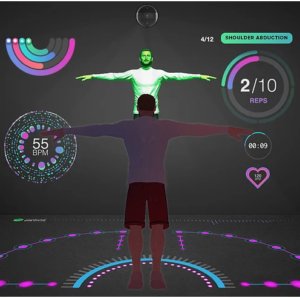
View Case Study
Spark is an autonomous rehabilitation platform that allows users to engage and make healthy progress in their recovery journey anywhere
Our team created this product during our class called "UX STUDIO 1" in Savannah College of Art and Design during the spring semester 2017 (March-June). We were a class consisted of juniors passionate about UX Design, and with a strong knowledge of the design and research process from classes taken previously. The students were split into groups of 5 to develop a product that will solve a problem with emerging technologies in 8 weeks.
Our team was an international group of 5 students from 5 different countries: South Korea, Argentina, USA, China, and India. Working within a pool of diverse cultures and perspectives was quite a challenge. We had our own ways of thinking, digesting and translating information. Although it was a rough start at first, we decided that there was no "perfect" way of doing anything. It wasn't just a matter of listening to each other, but also learning to communicate in a way that could help the listeners understand our ideas and what validated them.
Even though all of us were UX designers, for this project we needed other skill sets in order to bring our project alive. Luckily, each one of us had unique skills that complemented our project. We individually re-visited them (ex: 3D modeling+printing, motion media + video) and even learned new techniques such as motion capturing and visual effects rigging software to bring our product alive.
We were lucky to have access to different physical therapists as our main source of generating insights, as well as user testing in their area. Many of our design choices were altered after talking to the actual potential users, as well as the physical therapists. They gave us insights on little details to include such as resonant breathing and its importance, which is something we could have easily ignored in our process. Our team never stopped researching and testing. We were very persistent on making each feature purposeful and meaningful for our potential users.
- Why this project is worthy of a UX Award:
Although we like it or not, injuries are inevitable. Each year, 50% of Americans over the age of 18 develop a musculoskeletal injury that lasts longer than 3 months. However, only 30% of patients that utilize physical therapy services attend the visits that their insurance company authorizes. For patients to make progress in physical therapy, it isn't just about their physical endurance. It also heavily depends on the healthy mental state. The current physical therapy is time consuming, expensive and inaccessible. Often, people don't recover from their injuries properly simply because they don't stick to their treatments. Spark makes physical therapy fun, engaging and accessible in their personal environments through an Artificial Intelligence machine that uses a combination of two intelligent projectors and a 3D infrared sensor to overlay visuals and exercises tailored to the user’s injury and progress.
Using emerging technologies of machine learning and artificial intelligence taking over, we wanted to SPARK to become the perfect personal physical therapist that could help users perform their daily exercises correctly with Spark's voice coach, and the motivating visuals set out in the patient's room. The visuals can be projected accordingly to the user's space as it recognizes objects such as tables, or sofas in the room to use these objects as a part of an exercise, and not as something users would need to remove during the experience.
The role of machine learning in SPARK is to collect information during and after each exercise or routine on pain levels, and feedback. The constant communication between SPARK and the user is through voice control, so the users do not become frustrated from going back and forth of another controller.
- Submitted By: n/a
See More 2017 Submissions >>